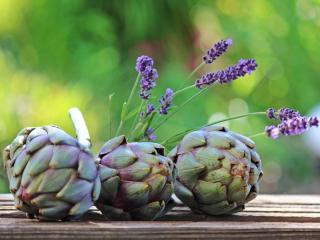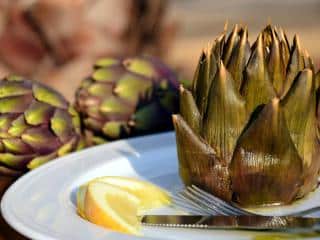

The artichoke hails from the Mediterranean and is a treat whether raw or cooked. People love its tender heart and unique taste. Here are few basic facts about artichoke.
Basic artichoke facts:
World production: 1.4 million tons (2016)
Enough for everyone on the planet to get one-half!
Production areas: Italy, Egypt, Spain
Availability: May through November
Peak season: May to June
Nutrition: 3.5 ounces of artichoke (100 g) offer 44.4 kcal
Seeds sprout starting in late April in greenhouses or from April-May outdoors. You’ll need patience: a year passes before the first harvest. Artichoke growing demands keen attention and expertise from growers. Soil requires frequent aerating and consistent watering. Harvesting starts when plants tower at around 3 feet. Each ripe artichoke is handpicked between May and late November. Harvest wraps up when a striking blue-purple flower emerges between the veggie’s scales.
There are two main varieties: Camus from Brittany, best cooked, and Violet from Provence, better raw.
Native to the Mediterranean basin, the artichoke arose from various botanical crossbreeds. First traces show up in Italy during the Renaissance (mid-16th century). Originally used as a remedy, it also had a saucy reputation as an aphrodisiac.

Its popularity skyrocketed to the point where five different species were present in Versailles during the Sun King’s era: White, Green, Purple, Red, and the Sweet Genovese.
But it wasn’t until 1810 that an agronomist from the Paris region developed the “Camus de Bretagne,” today’s favorite among the French. This deep green and ashy variety has a rounded, tight head with broad, short scales.
Buying artichoke:

For a fresh artichoke pick, ensure the stem feels slightly damp and shows a fresh color.
Storing artichoke:
Artichokes have a short fridge shelf life in the vegetable drawer.
Preparing artichoke:
Whether you’re eating your artichoke raw or cooked, give it a quick rinse. If eating it raw, ensure you dry it well; it’ll taste crisper.
For cooking, let it simmer for 20 to 40 minutes (depending on size) in boiling salted water. How to know it’s done? Just give a leaf a tug; if it pulls off easily, it’s ready.